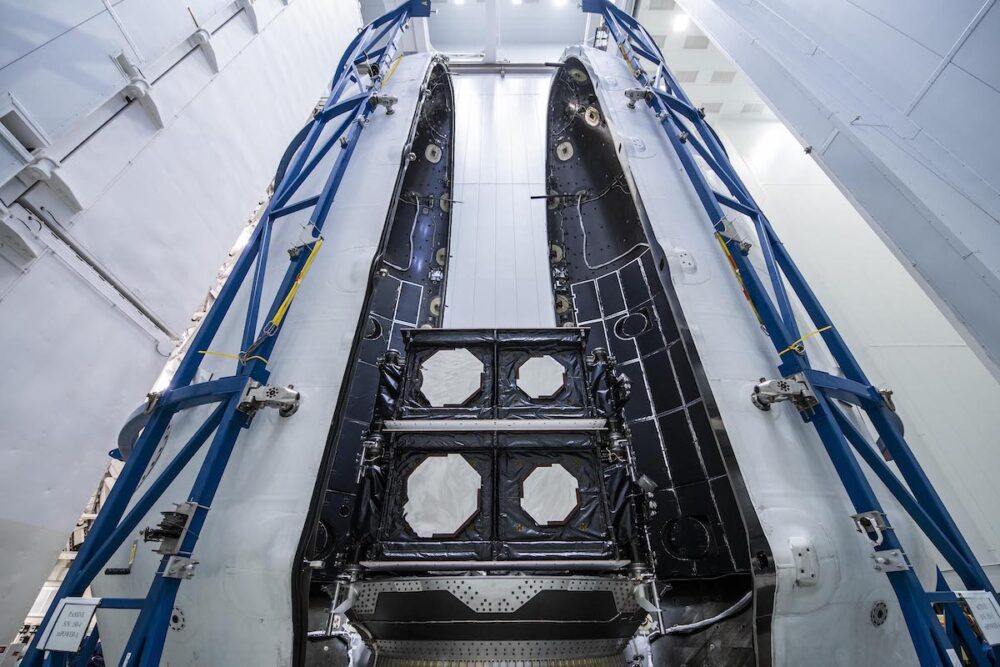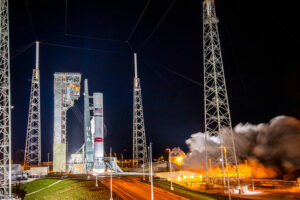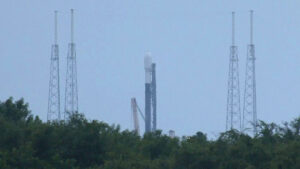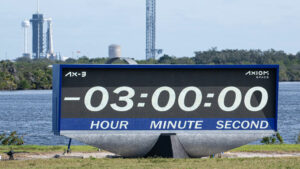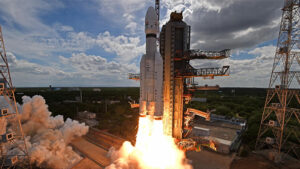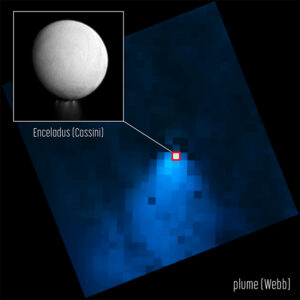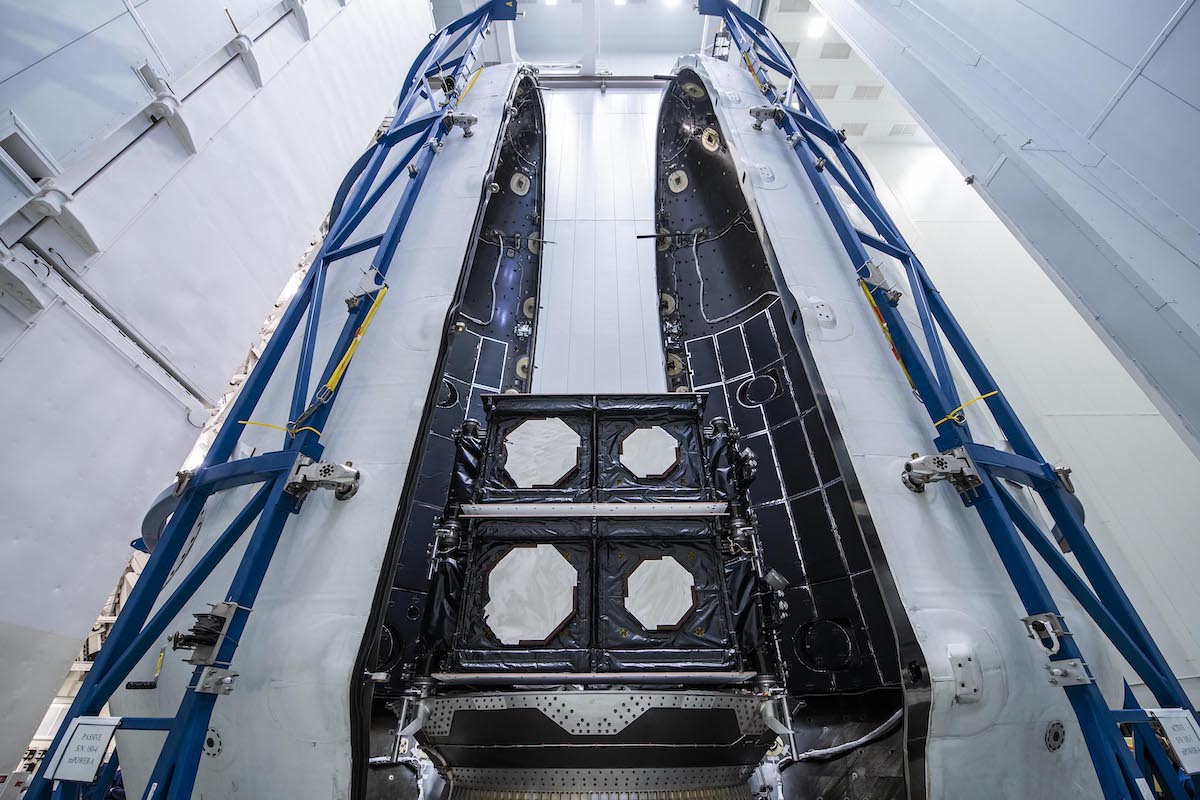
The first two spacecraft in an 11-satellite refresh of SES’s Medium Earth Orbit O3b internet constellation are poised to ride a SpaceX Falcon 9 rocket into space from Cape Canaveral on Friday, less than two weeks after shipment to the Florida spaceport from a Boeing factory in California already fully fueled and integrated for launch.
The two O3b mPOWER spacecraft arrived at Cape Canaveral on Dec. 3 after a cross-country flight from Boeing’s commercial satellite manufacturing plant in El Segundo, California. Boeing engineers in California connected the two satellites together into their launch configuration at the factory, accomplishing a task more typically done at the launch site in the final weeks before liftoff.
The satellites rode a Ukrainian Antonov An-124 cargo plane from California to the Florida spaceport. Boeing also loaded xenon gas into the satellites’ propulsion systems before the departed the factory near Los Angeles International Airport, a company official told Spaceflight Now. The xenon will fuel the low-thrust, but highly efficient plasma thrusters on each satellite.
The design of the satellites allowed Boeing to slash the time required to ready the O3b mPOWER spacecraft for launch. Instead of mating the satellites and fueling them at Cape Canaveral, Boeing only needed to complete final functional testing on the satellites before encapsulating them inside the Falcon 9 rocket’s nose cone.
The two O3b spacecraft, when combined, weigh roughly 9,000 pounds (4,100 kilograms) in launch configuration, a Boeing official told Spaceflight Now.
The O3b mPOWER satellites will beam high-speed internet services around the world, providing “fiber-like” connectivity to users between 50 degrees north and south latitude, according to SES, the Luxembourg-based operator that owns the O3b fleet.
SES already has 20 O3b satellites in Medium Earth Orbit. They flew to space on Russian Soyuz rockets under a launch services contract with Arianepace.
The new O3b mPOWER satellites will operate in a similar equatorial orbit as the original O3b satellites about 5,000 miles (8,000 kilometers) above Earth.
“SES’s O3b mPOWER system is a true gamechanger and will transform the way people think about connectivity,” said Ruy Pinto, chief technology officer at SES. “Delivering performance above all, O3b mPOWER will offer connectivity services to government organizations and enterprises based in the most remote regions. In times of natural disasters, when networks are disrupted, O3b mPOWER’s low-latency services can quickly restore critical communications networks.”
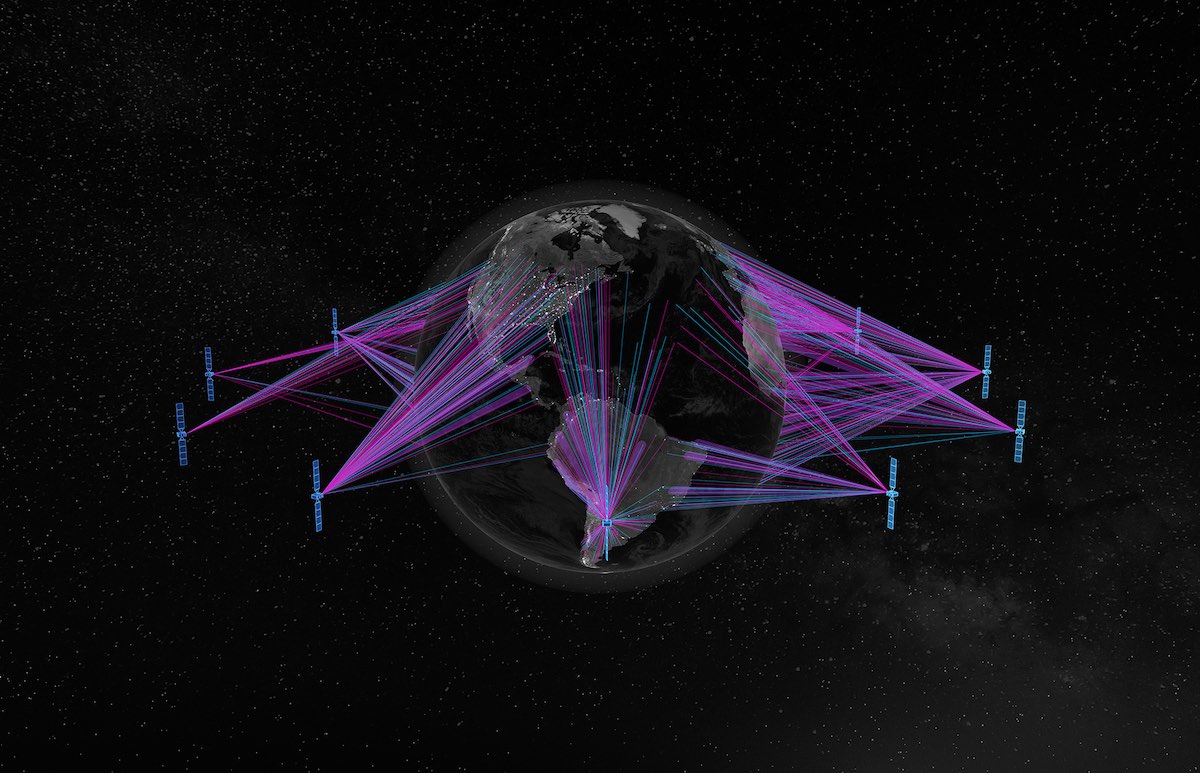
The original O3b satellites, built by Thales Alenia Space nearly a decade ago, had 10 user beams per spacecraft. The new O3b mPOWER satellites, built on Boeing’s 702 spacecraft platform, each have more than 4,000 beams that can be adjusted to focus bandwidth on high-demand areas.
SES has focused on developing broadband satellites for a Medium Earth Orbit, or MEO, constellation, which puts the relay stations closer to Earth than geostationary orbit some 22,000 miles over the planet. That reduces the latency, or lag, in internet signals compared to geostationary satellites. As few as three geostationary satellites could provide global coverage, but more satellites in MEO required to reach around the world.
But that number is still far fewer than the hundreds or thousands of internet satellites companies like SpaceX and OneWeb are launching into low Earth orbit. Satellites flying less than 1,000 miles above Earth reduce latency even further than MEO satellites, but many more spacecraft are needed for global coverage.
Boeing is contracted to build 11 O3b mPOWER satellites. More O3b mPOWER payloads are scheduled to launch on Falcon 9 rockets in 2023.
O3b stands for “Other 3 Billion” in recognition of the billions of people without access to reliable internet service.
“SES approached us with a vision to create global equity, by providing people with high-speed connectivity where it wasn’t economically or physically feasible to build fiber infrastructure,” said Jim Chilton, senior vice president of space and launch at Boeing. “We partnered to create a super computer constellation in space to meet that goal, and we can’t wait to see what SES does as the 702X platform’s first user.”
The first two O3b mPOWER satellites are stacked on on top of the other for liftoff at 4:21 p.m. EST (2121 GMT) Friday from pad 40 at Cape Canaveral Space Force Station, Florida. A Falcon 9 rocket will give the two satellites a boost into an elliptical MEO transfer orbit, then the satellites will use their electric propulsion system to maneuver into the final circular operational orbit.
The O3b mPOWER satellites should reach their circular 5,000-mile-high perch around April, according to SES.
Email the author.
Follow Stephen Clark on Twitter: @StephenClark1.
- SEO Powered Content & PR Distribution. Get Amplified Today.
- Platoblockchain. Web3 Metaverse Intelligence. Knowledge Amplified. Access Here.
- Source: https://spaceflightnow.com/2022/12/15/first-o3b-mpower-broadband-satellites-set-for-liftoff-after-abbreviated-launch-campaign/
- 000
- 1
- 10
- 100
- 11
- 9
- a
- About
- above
- access
- accomplishing
- According
- Adjusted
- After
- airport
- All
- already
- and
- Angeles
- Another
- April
- areas
- around
- author
- Bandwidth
- based
- Beam
- before
- between
- billions
- Boeing
- boost
- broadband
- build
- built
- california
- Campaign
- chief
- chief technology officer
- closer
- COM
- combined
- commercial
- Communications
- Companies
- company
- compared
- complete
- computer
- Configuration
- connected
- Connectivity
- contract
- could
- coverage
- create
- credit
- critical
- decade
- Design
- developing
- disasters
- each
- earth
- efficient
- Electric
- Engineers
- enterprises
- equity
- Ether (ETH)
- Even
- factory
- feasible
- few
- final
- First
- FLEET
- flight
- florida
- flying
- Focus
- focused
- Force
- Friday
- from
- Fuel
- fully
- functional
- further
- GAS
- Give
- Global
- GMT
- goal
- Government
- highly
- HTTPS
- Hundreds
- in
- Infrastructure
- instead
- integrated
- International
- Internet
- IT
- Jim
- Latency
- launch
- launching
- los
- Los Angeles
- Low
- manufacturing
- many
- max-width
- medium
- Meet
- more
- most
- Natural
- Near
- nearly
- networks
- New
- North
- nose
- number
- offer
- Officer
- official
- operate
- operational
- operator
- Orbit
- organizations
- original
- Other
- owns
- pad
- partnered
- People
- performance
- PHP
- Physically
- planet
- Plasma
- platform
- Platforms
- plato
- Plato Data Intelligence
- PlatoData
- Post
- president
- propulsion
- provide
- providing
- Puts
- Quick
- quickly
- reach
- ready
- recognition
- reduce
- reduces
- regions
- reliable
- remote
- required
- return
- Ride
- roughly
- russian
- Said
- satellite
- satellites
- scheduled
- service
- Services
- set
- Share
- should
- signals
- similar
- site
- some
- South
- Space
- Space Force
- Spaceport
- SpaceX
- stacked
- stands
- station
- Stations
- Stephen
- Still
- Super
- system
- Systems
- Task
- Technology
- Testing
- The
- the world
- their
- thousands
- three
- time
- times
- to
- together
- top
- transfer
- Transform
- true
- tweet
- typically
- Ukrainian
- under
- us
- use
- User
- users
- Vice President
- vision
- wait
- Weeks
- weigh
- What
- which
- will
- without
- world
- zephyrnet

